I Am Not a Serial Killer Read online
I AM NOT A
SERIAL KILLER
I AM NOT A
SERIAL KILLER
DAN WELLS
A TOM DOHERTY ASSOCIATES BOOK
NEW YORK
The author and publisher have provided this e-book to you without Digital Rights Management software (DRM) applied so that you can enjoy reading it on your personal devices. This e-book is for your personal use only. You may not print or post this e-book, or make this e-book publicly available in any way. You may not copy, reproduce or upload this e-book, other than to read it on one of your personal devices.
Copyright infringement is against the law. If you believe the copy of this e-book you are reading infringes on the author’s copyright, please notify the publisher at: us.macmillanusa.com/piracy.
This is a work of fiction. All of the characters, organizations, and events portrayed in
this novel are either products of the author’s imagination or are used fictitiously.
I AM NOT A SERIAL KILLER
Copyright © 2010 by Dan Wells
All rights reserved.
Excerpt of “The Love Song of J. Alfred Prufrock,” from Collected Poems 1909–1962,
by T. S. Eliot, used by permission of Faber and Faber, Ltd.
A Tor Book
Published by Tom Doherty Associates, LLC
175 Fifth Avenue
New York, NY 10010
www.tor-forge.com
Tor® is a registered trademark of Tom Doherty Associates, LLC.
Library of Congress Cataloging-in-Publication Data
Wells, Dan, 1977–
I am not a serial killer / Dan Wells.—1st ed.
p. cm.
“A Tom Doherty Associates book.”
ISBN 978-0-7653-2247-0
1. Serial murderers—Fiction. I. Title.
PS3623.E4688I3 2010
813’.6—dc22
2009040729
First Edition: April 2010
Printed in the United States of America
0 9 8 7 6 5 4 3 2 1
For Rob, who gave me the best incentive
a little brother can give, he got published first.
Acknowledgments
This book owes its existence to many people, most of whom are (to my knowledge) not serial killers.
First and foremost I must mention Brandon Sanderson, who shut me up in the car one day and told me to stop talking about serial killers and just write a book about them. That turned out to be a pretty good idea. This idea was further developed and refined by a series of writing groups and critical readers, including (but not limited to) Peter Ahlstrom, Karla Bennion, Steve Diamond, Nate Goodrich, Nate Hatfield, Alan Layton, Jeanette Layton, Drew Olds, Ben Olsen, Bryce Moore, Janci Patterson, Emily Sanderson, Ethan Skarstedt, Isaac Stewart, Eric James Stone, Sandra Tayler, and Kaylynn Zobell.
In the professional realm I must thank my editor, Moshe Feder, and my absolutely incredibly wonderful agent, Sara Crowe. Without their help this book might still be okay, but it wouldn’t be awesome and you’d have never heard of it. If you find that it is awesome, and, indeed, if you find it at all, you have them to thank.
Special acknowledgment goes to my loving wife, Dawn, who supported me all through the writing of this book and then didn’t leave me after she’d read it. Other family members who didn’t abandon me include my sister Allison, my brother Rob, my mother-in-law, Martha, and my poor parents, Robert and Patty. To all of you: let me please reiterate that this book is not autobiographical. I promise.
I should have been a pair of ragged claws
Scuttling across the floors of silent seas.
—The Love Song of J. Alfred Prufrock.
T. S. ELIOT
I AM NOT A
SERIAL KILLER
1
Mrs. Anderson was dead.
Nothing flashy, just old age—she went to bed one night and never woke up. They say it was a peaceful, dignified way to die, which I suppose is technically true, but the three days it took for someone to realize they hadn’t seen her in a while removed most of the dignity from the situation. Her daughter eventually dropped by to check on her and found her corpse three days rotted and stinking like roadkill. And the worst part isn’t the rotting, it’s the three days—three whole days before anyone cared enough to say, “Wait, where’s that old lady that lives down by the canal?” There’s not a lot of dignity in that.
But peaceful? Certainly. She died quietly in her sleep on August thirtieth, according to the coroner, which means she died two days before something tore Jeb Jolley’s insides out and left him in a puddle behind the Laundromat. We didn’t know it at the time, but that made Mrs. Anderson the last person in Clayton County to die of natural causes for almost six months. The Clayton Killer got the rest.
Well, most of them. All but one.
We got Mrs. Anderson’s body on Saturday, September second, after the coroner was done with it—or, I guess I should say that my mom and Aunt Margaret got the body, not me. They’re the ones who run the mortuary; I’m only fifteen. I’d been in town most of the day, watching the police clean up the mess with Jeb, and came back just as the sun was beginning to go down. I slipped in the back just in case my mom was up front. I didn’t really want to see her.
No one was in the back yet, just me and Mrs. Anderson’s corpse. It was lying perfectly still on the table, under a blue sheet. It smelled like rotten meat and bug spray, and the lone ventilator fan buzzing loudly overhead wasn’t doing much to help. I washed my hands quietly in the sink, wondering how long I had, and gently touched the body. Old skin was my favorite—dry and wrinkled, with a texture like antique paper. The coroner hadn’t done much to clean up the body, probably because they were busy with Jeb, but the smell told me that at least they’d thought to kill the bugs. After three days in end-of-summer heat, there had probably been a lot of them.
A woman swung open the door from the front end of the mortuary and came in, looking like a surgeon in her green scrubs and mask. I froze, thinking it was my mother, but the woman just glanced at me and walked to a counter.
“Hi John,” she said, collecting some sterile rags. It wasn’t my mom at all, it was her sister Margaret—they were twins, and when their faces were masked I could barely tell the difference. Margaret’s voice was a little lighter, though, a little more . . . energetic. I figured it was because she’d never been married.
“Hi, Margaret.” I took a step back.
“Ron’s getting lazier,” she said, picking up a squirt bottle of Dis-Spray. “He didn’t even clean her, just declared natural causes and shipped her over. Mrs. Anderson deserves better than this.” She turned to look at me. “You just gonna stand there or are you gonna help me?”
“Sorry.”
“Wash up.”
I rolled up my sleeves eagerly and went back to the sink.
“Honestly,” she went on, “I don’t even know what they do over there at the coroner’s office. It’s not like they’re busy—we can barely stay in business here.”
“Jeb Jolley died,” I said, drying my hands. “They found him this morning behind the Wash-n-Dry.”
“The mechanic?” asked Margaret, her voice dropping lower. “That’s terrible. He’s younger than I am. What happened?”
“Murdered,” I said, and pulled a mask and apron from a hook on the wall. “They thought maybe it was a wild dog, but his guts were kind of in a pile.”
“That’s terrible,” Margaret said again.
“Well, you’re the one worried about going out of business,” I said. “Two bodies in one weekend is money in the bank.”
“Don’t even joke like that, John,” she said, looking at me sternly. “Death is a sad thing, even when it pay
s your mortgage. You ready?”
“Yes.”
“Hold her arm out.”
I grabbed the body’s right arm and pulled it straight. Rigor mortis makes a body so stiff you can barely move it, but it only lasts about a day and a half and this one had been dead so long the muscles had all relaxed again. Though the skin was papery, the flesh underneath was soft, like dough. Margaret sprayed the arm with disinfectant and began wiping it gently with a cloth.
Even when the coroner does his job and cleans the body, we always wash it ourselves before we start. Embalming’s a long process, with a lot of very precise work, and you need a clean slate to start with.
“It stinks pretty bad,” I said.
“She.”
“She stinks pretty bad,” I said. Mom and Margaret were adamant that we be respectful to the deceased, but it seemed a little late at this stage. It wasn’t a person anymore, it was just a body. A thing.
“She does smell,” said Margaret. “Poor woman. I wish someone had found her sooner.” She looked up at the ventilator fan buzzing behind its grate in the ceiling. “Let’s hope the motor doesn’t burn out on us tonight.” Margaret said the same thing before every embalming, like a sacred chant. The fan continued creaking overhead.
“Leg,” she said. I moved down to the body’s foot and pulled the leg straight while Margaret sprayed it. “Turn your head.” I kept my gloved hands on the foot and turned to stare at the wall while Margaret lifted up the sheet to wash the upper thighs. “One good thing that came of this, though,” she said, “is that you can bet every widow in the county got a visit today, or is going to get one tomorrow. Everyone who hears about Mrs. Anderson is going to go straight to their own mother, just to make sure. Other leg.”
I wanted to say something about how everyone who heard about Jeb would go straight to their auto mechanic, but Margaret never appreciated jokes like that.
We moved around the body, leg to arm, arm to torso, torso to head, until the whole thing was scrubbed and disinfected. The room smelled like death and soap. Margaret tossed the rags in the laundry bin and started gathering the real embalming supplies.
I’d been helping Mom and Margaret at the mortuary since I was a little boy, back before Dad left. My first job had been cleaning up the chapel: picking up programs, dumping out ashtrays, vacuuming the floor, and other odd jobs that a six-year-old could do unassisted. I got bigger jobs as I grew older, but I didn’t get to help with the really cool stuff—embalming—until I was twelve. Embalming was like . . . I don’t know how to describe it. It was like playing with a giant doll, dressing it and bathing it and opening it up to see what was inside. I watched Mom once when I was eight, peeking in through the door to see what the big secret was. When I cut open my teddy bear the next week, I don’t think she made the connection.
Margaret handed me a wad of cotton, and I held it at the ready while she packed small tufts carefully under the body’s eyelids. The eyes were beginning to recede, deflating as they lost moisture, and cotton helped keep the right shape for the viewing. It helped keep the eyelids closed as well, but Margaret always added a bit of sealing cream, just in case, to keep the moisture in and the lid closed.
“Get me the needle gun, will you John?” she asked, and I hurried to put down the cotton and grab the gun from a metal table by the wall. The gun is a long metal tube with two fingerholds on the side, like a hypodermic syringe.
“Can I do it this time?”
“Sure,” she said, pulling back the body’s cheek and upper lip. “Right here.”
I placed the gun gently up against the gums and squeezed, embedding a small needle into the bone. The teeth were long and yellow. We added one more needle to the lower jaw and threaded a wire through them both, then twisted it tight to keep the mouth closed. Margaret smeared sealing cream on a small plastic support, like the peel of an orange wedge, and placed it inside the mouth to hold everything closed.
Once the face was taken care of we arranged the body carefully, straightening the legs and folding the arms across the chest in the classic “I’m dead” pose. Once the formaldehyde gets into the muscles, they seize up and go rigid. You have to set the features first thing, so the family doesn’t have a misshapen corpse at the viewing.
“Hold her head,” said Margaret, and I obediently put a hand on each side of the corpse’s head to keep it steady. Margaret probed with her fingers a bit, just above the right collarbone, and then sliced a long, shallow line in the hollow of the old woman’s neck. It’s almost bloodless when you cut a corpse. Because the heart’s not pumping, there’s no blood pressure, and gravity pulls all the blood down into the body’s back. Because this one had been dead longer than usual, the chest was limp and empty while the back was nearly purple, like a giant bruise. Margaret reached into the hole with a small metal hook and pulled out two big veins—well, technically an artery and a vein—and looped a string around each one. They were purple and slick, two dark loops that pulled out of the body a few inches, and then slipped back in. Margaret turned to prepare the pump.
Most people don’t realize how many different chemicals embalmers use, but the first thing that catches your eye is not how many there are, but how many different colors they are. Each bottle—the formaldehyde, the anticoagulants, the cauterants, the germicides, the conditioners, and others—has its own bright color, like fruit juice. The row of embalming fluids looks like the syrup flavors at a sno-cone stand. Margaret chose her chemicals carefully, like she was choosing ingredients for a soup. Not every body needed every chemical, and figuring out the right recipe for a given corpse was as much an art as a science. While she worked on that, I let go of the head and picked up the scalpel. They didn’t always let me make incisions, but if I did it while they weren’t watching, I could usually get away with it. I was good at it, too, which helped.
The artery Margaret had pulled out would be used to pump the body full of the chemical cocktail she was making; as they filled the body, the old fluids, like blood and water, would be pushed out the exposed vein and into a drain tube, and from there into the floor. I had been surprised to find out that it all just goes into the sewer system, but really—where else would it go? It’s no worse than anything else down there. I held the artery steady and cut slowly across it, careful not to sever it completely. When the hole was ready, I grabbed the canula—a curved metal tube—and slipped the narrow end into the opening. The artery was rubbery, like a thin hose, and covered with tiny fibers of muscle and capillary. I laid the metal tube gently on the chest and made a similar cut in the vein, this time inserting a drain pipe, which connected to a long coil of clear plastic tubing that snaked down into a drain in the floor. I cinched tight the strings Margaret had looped around each vein, sealing them shut.
“That looks good,” said Margaret, pushing the pump over to the table. It was on wheels to keep it out of the way, but now it took its place of honor in the center of the room while Margaret connected the main hose to the canula I’d placed in the artery. She studied the seal briefly, nodded at me in approval, and poured the first chemical—a bright orange anticoagulant to break up clots—into the tank on top of the pump. She pushed a button and the pump jerked sleepily to life, syncopated like a real heartbeat, and she watched it carefully while she fiddled with the knobs that controlled pressure and speed. The pressure in the body normalized quickly, and soon dark, thick blood was disappearing into the sewer.
“How’s school?” Margaret asked, peeling off a rubber glove to scratch her head.
“It’s only been a couple of days,” I said. “Not a lot happens in the first week.”
“It’s the first week of high school, though,” said Margaret. “That’s pretty exciting, isn’t it?”
“Not especially,” I said.
The anticoagulant was almost gone, so Margaret poured a bright blue conditioner into the pump to help get the blood vessels ready for the formaldehyde. She sat down. “Meet any new friends?”
“Yeah,”
I said. “A whole new school moved into town over the summer, so miraculously I’m not stuck with the same people I’ve known since kindergarten. And of course, they all wanted to make friends with the weird kid. It was pretty sweet.”
“You shouldn’t make fun of yourself like that,” she said.
“Actually, I was making fun of you.”
“You shouldn’t do that either,” said Margaret, and I could tell by her eyes that she was grinning slightly. She stood back up to add more chemicals to the pump. Now that the first two chemicals were on their way through the body, she began mixing the true embalming fluid—a moisturizer and a water softener to keep the tissues from swelling, preservatives and germicides to keep the body in good condition (well, as good as it could be at this point), and dye to give it a rosy, lifelike glow. The key to it all, of course, is formaldehyde, a strong poison that kills everything in the body, hardens the muscles, pickles the organs, and does all of the actual “embalming.” Margaret added a hefty dose of formaldehyde, followed by thick green perfume to cover the pungent aroma. The pump tank was a swirly pot of brightly colored goop, like the slush machine at a gas station. Margaret clamped down the lid and ushered me out the back door; the fan wasn’t good enough to risk being in the room with that much formaldehyde. It was fully dark outside now, and the town had gone almost silent. I sat on the back step while Margaret leaned against the wall, watching through the open door in case anything went wrong.
“Do you have any homework yet?” she asked.
“I have to read the introductions of most of my textbooks over the weekend, which of course everybody always does, and I have to write an essay for my history class.”
Margaret looked at me, trying to be nonchalant, but her lips were pressed tightly together and she started blinking. I knew from long association that this meant something was bothering her.

 Partials
Partials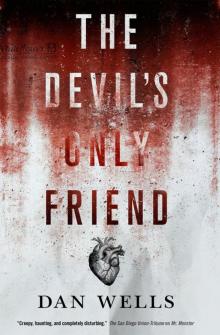 The Devil's Only Friend
The Devil's Only Friend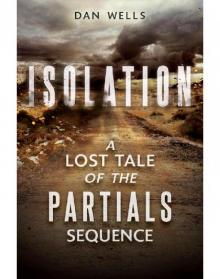 Isolation
Isolation I Don't Want to Kill You
I Don't Want to Kill You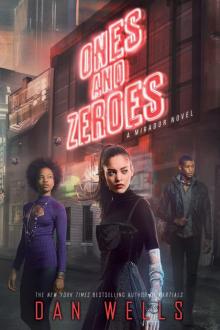 Ones and Zeroes
Ones and Zeroes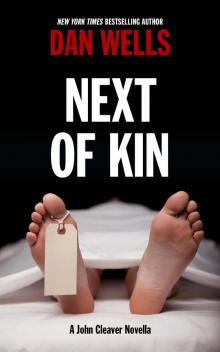 Next of Kin
Next of Kin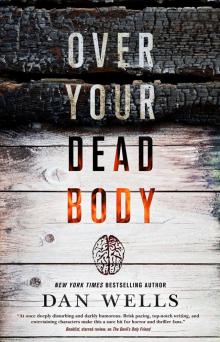 Over Your Dead Body
Over Your Dead Body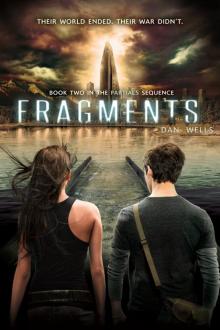 Fragments
Fragments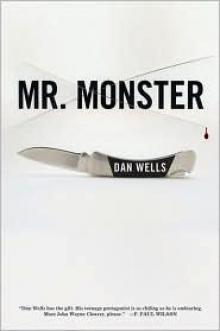 Mr. Monster
Mr. Monster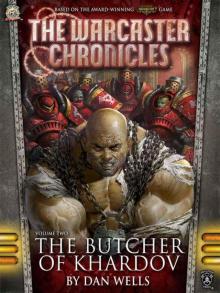 The Butcher of Khardov
The Butcher of Khardov I AM NO T A S E RI AL KI L L E R
I AM NO T A S E RI AL KI L L E R Nothing Left to Lose--A Novel
Nothing Left to Lose--A Novel Active Memory
Active Memory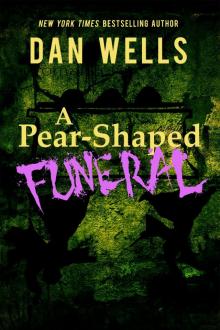 A Pear-Shaped Funeral
A Pear-Shaped Funeral I Am Not a Serial Killer
I Am Not a Serial Killer Bluescreen
Bluescreen Ruins
Ruins Zero G
Zero G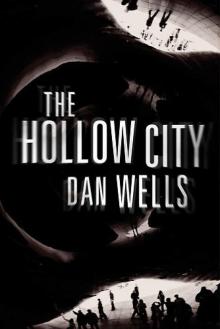 The Hollow City
The Hollow City Extreme Makeover
Extreme Makeover Partials p-1
Partials p-1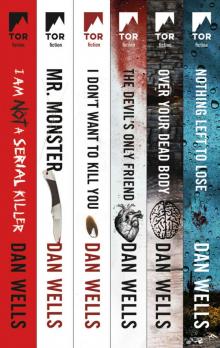 The Complete John Wayne Cleaver Series: I Am Not a Serial Killer, Mr. Monster, I Don't Want to Kill You, Devil's Only Friend, Over Your Dead Body, Nothing Left to Lose
The Complete John Wayne Cleaver Series: I Am Not a Serial Killer, Mr. Monster, I Don't Want to Kill You, Devil's Only Friend, Over Your Dead Body, Nothing Left to Lose